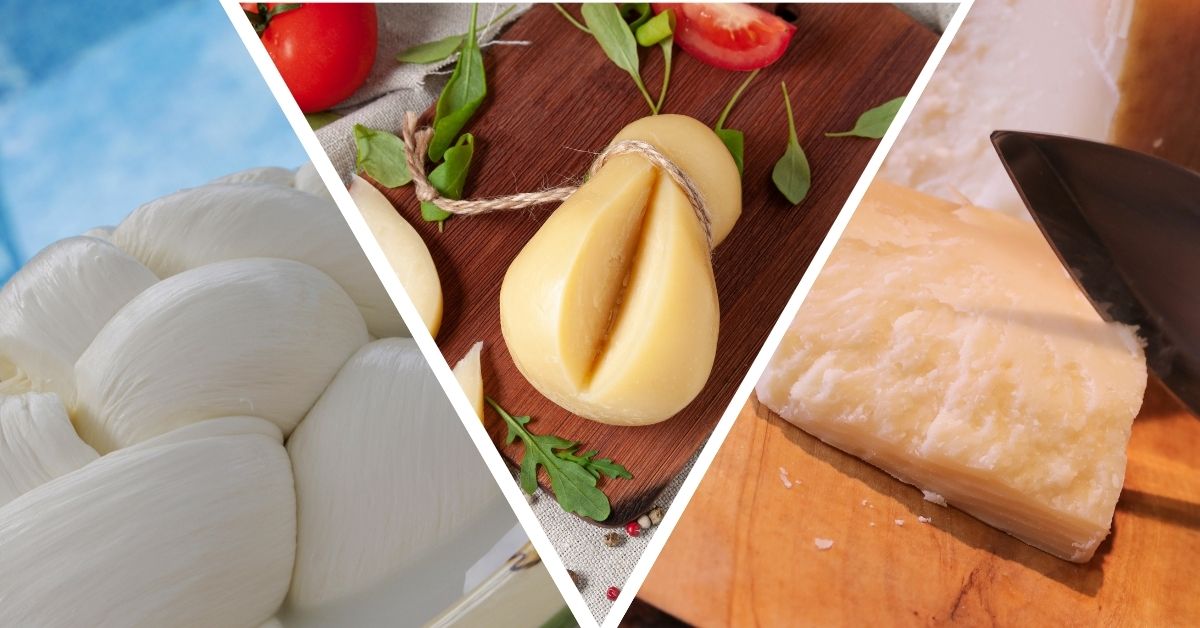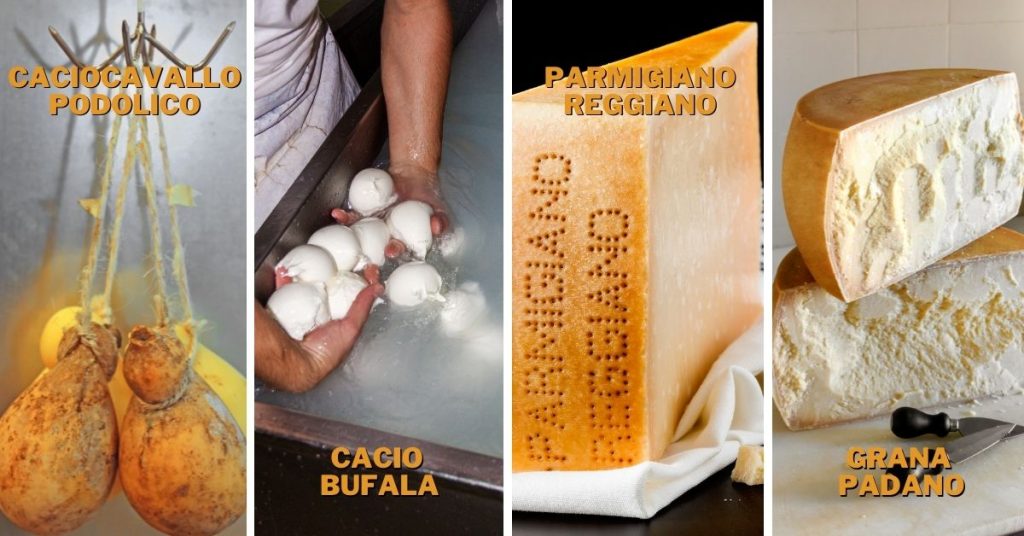List of Expensive Italian Cheeses to Try

Today Italy counts 450 cheese varieties from soft, semi-hard, and complex types. In addition, every region of Italy has its own cheese families that identify them. Talking about the cheese industry in Italy would need endless literature, but let’s see what are the most expensive Italian cheeses you need to try!
The most expensive Italian cheese is Caciocavallo Podolico, with a price of $50 per pound. Cacio Bufala is the second most costly cheese, costing $45 per pound. Both these kinds of cheese are produced in small quantities, and that’s why their price is this generous. Parmigianno Regianno and Grana Padano are also considered very expensive.
If you love Italian cheeses, this article will overview the best and sharp cheeses and some detailed explanations of what makes Italian cheeses this special and unique.
What Are the Most Expensive Italian Cheeses?
Here’s a cheat sheet to look at before we start.
| Taste | Region | Uniqueness | Price | |
|---|---|---|---|---|
| Caciocavallo Podolico | Spicy and complex | Basilicata | High-quality milk | $50 |
| Cacio Bufala | Sweet | Campagne | Can be produced all year long | $45 |
| Parmigiano Reggiano | Salty, milky and strong | Emilia Romagna | Aging process | $20 |
| Grana Padano | Nutty and buttery taste | Padana | Grainy texture | €15 |
Caciocavallo Podolico
One of Italy’s most extraordinary and unique cheeses is the Caciocavallo Podolico of Basilicata. The particular element is that it is made only from the cows of the Podolica breed. The surface in which this breed is grown is considered small, but the cheese’s quality is supreme.
The demand and supply ratio makes the price very high compared with other Italian cheeses. Caciocavallo’s price can go up by $50 per pound.
Someone may ask: but why don’t producers raise this type of cow in more regions? A precise response is difficult to be stated, but some reasons may be as below.
Some cows may be fragile to the environment. It can be difficult for them to survive in a region that does not have the same climatic and geographic conditions as Basilicata. However, the climate, weather, and territory conditions help the cows be raised in their best need to produce good milk.
Also, the quality of animal feed in this region may be the most suitable to keep unchanged the organoleptic attributes of the cheese. The taste is sweet initially, but it may be more spicy and piquant as the time passes.
This cheese does not need a long maturation time. It can be consumed after three months, but the more it stays, the more complex the taste can be.
Parmiggiano Reggiano
One of the most expensive cheeses is Parmigiano Reggiano. The authentic and original Parmigiano Reggiano is costly due to the raw materials used and production processes. It starts with monitoring the breeding farms and ensuring that the best quality milk will be granted.
The milk goes through lengthy processing that requires time and patience, like coagulation, cutting, branding, and salting. Only the salting process requires at least 21 days in a pool of water and salt. After that, the wheels need to be turned every hour on their other side.
The most significant price differentiation comes from two additional marks that Parmigianno may have: premium and export. Those titles can be granted only after eighteen months of maturation.
Both those brands show the supreme quality of the cheese and, in addition, a higher price. You can find the logos in the cheese packaging and other quality marks.
Overall, Parmigianno maturated for more than thirty months has a higher price than other types. This price may start from €20. But depending on the brand that is selling it, the distance from the place of origin, and accessibility, this price may be higher and may reach $70 per kilogram.
Granna Padano
Another excellent and expensive cheese is Grana Padano. Grana is, in fact, the number one cheese in Italy, and I have explained below why. Granna Padano is a little cheaper than Parmigianno Regianno, as the wide of the territory produced is bigger. For this reason, consumption is higher.
Granna Padano’s price can be around €15 per pound or more, depending on the brand and supermarket. Due to the production and maturation process, Grana is naturally lactose-free, so it’s very suitable to be consumed even by lactose-intolerant people.
Cacio Bufala
Another expensive Italian cheese is Cacio Bufala, obtained from pasteurized water buffalo milk. This cheese originates from the Campania region and has a cylindrical shape.
The texture of Cacio Bufala is solid and has a complexity of smells and some slightly sweet flavor. It has a yellow color and more white on the inside. The aging process in Cacio Buffalo is around eight months and is done in natural caves.
After the cheese needs to be salted in brine for two more months, this artisanal semi-hard cheese can be produced all year long and has a fat percentage of around forty percent.
It is a little similar to Provolone Valpadana, but if you taste them carefully, you will feel a more complex taste in Cacio Bufala. That’s why the price of this cheese is higher than provolone, as it costs around $45 per pound.

What Is the Most Expensive Cheese in Italy?
From the list above, the most expensive cheese is considered Caciocavallo Podolico, as its price starts from $50 per pound. This cheese is deemed rare due to the small quantity of production. The demand for it is high, and the supply is low, and that’s why the price is this high.
What Is the Most Expensive Italian Cheese Brand?
It is hard to find one more expensive brand than the others, considering Italy has 450 cheese varieties and numerous manufacturers.
Although, I have noticed a brand with great prices, L’Antica Cascina. This brand has worked intensely towards internalization and has achieved BRC (British Retail Consortium) certification, the highest in Europe, ensuring international food safety standards.
They have at least forty-two selections of cheeses that they export worldwide.
What Is the Number One Cheese in Italy?
Regarding popularity and production volume, the number one cheese in Italy is Grana Padano. In 2016, more than 185 tonnes of cheese were produced, for which 2,6 million tonnes were used. This value has been 35% of all cheese production in Italian markets.
Grana Padano is a very ancient cheese as it originates from at least 1504. Grana is salty and has a grainy texture, from which the name was generated. This type of cheese is fantastic for antipasti and cheese platters, pasta, and hot sauces, and you can put it on top of almost everything.
What is important to mention is how to recognize the real and the original Grana Padano from other Grana cheeses produced in the market. In every packaging of the authentic Grana Padano, there are two logos.
A yellow logo in the shape of the rhombus that writes Grana Padano, and the other one is the red logo of the European Union called PDO, which proves that every part of the production, processing, and preparation process takes place in a specific region that is Padana, Italy. [1]
Only a cheese with both those logos is considered the real Grana Padano and is the one I am talking about today, and that is worth consuming.
Part of Grana cheese is also Parmigiano Reggiano, Italy’s second most famous cheese. Parmigiano Reggiano is also an artisanal variety that is long, ripened, and hard-cooked. Parmigiano Reggiano has three initial maturation stages one, two, and three years.
One year of maturation is softer, while the more maturated, the more complex, grainy, and better it becomes.
What Is the Sharpest Italian Cheese?
In the long list of Italian cheeses, the tastes are endless. Some of them are sweet and soft, some extremely salty or with a firm texture, so it depends on the purpose or your preference which will you consume.
The phrase sharp cheese stands more for cheeses with a solid and intense taste. Considering this, I would recommend two: Gorgonzola and Provolone Valpadana.
So, the first choice for a sharp taste will be Gorgonzola, a soft and white cheese. Gorgonzola has some blue spots that are, in fact, mold and are the essential feature of this cheese. Gorgonzola is creamy and soft but very spicy and bitter due to the mold.
Gorgonzola is one of those cheeses that you either like from the beginning or don’t like. It has a specific sharp taste that mixes the spiciness with sweet and earthy tones.
The second choice for a sharp Italian cheese is Provolone Valpadana. This is a semi-hard cheese that has a complex production process that creates, in the end, a tough and strong taste. Provolone is offered in two tastes: mild and piquant, but you can also find those tastes smoked and/or aged for some time. It has a milky aroma with some butter tones, and sometimes you can also feel some fruit aroma.
What Is Special About Italian Cheese?
Italy is known as one of the world’s best countries for producing cheeses, so randomly, a question may occur to your mind: what is so particular about Italian cheeses?
Firstly this industry has been improving forever in Italy; historical evidence proves that Italians have been making cheese since the 19th century. Time shows that this industry has been developing for a long time.
Secondly, one of the main secrets and success elements in Italian cheeses is the milk and rennets used to produce the cheeses. The regions have a significant impact on the quality of milk. Po Valley is one of the most important regions offering milk made from some of the best Italian cheeses like Parmigiano Reggiano and grana Padano.
This region, Po Valley, has very developed agriculture favored by the conditions like conformation of the territory, the abundance of water, and the temperate climate. Those elements provide an environment for feeding and breeding dairy cattle breeds. Due to all those factors, this area can produce an immense quantity of food like milk which is the raw material of cheese.
Rennets used are also another element that differenties Italian cheeses. Italian producers have passed from one generation to another the typicity of rennets.
Thirdly, every Italian cheese has its way of production. The type and quantity of rennets used, the coagulation process, drying, and salting can be very different. This creates fantastic diversity in the cheese sector in Italy.
And lastly, the branding philosophy that Italian farms follow. The secret is hidden behind every good cheese by numerous farmers who collaborate, intending to keep the cheese’s name and prestige to a high standard.
